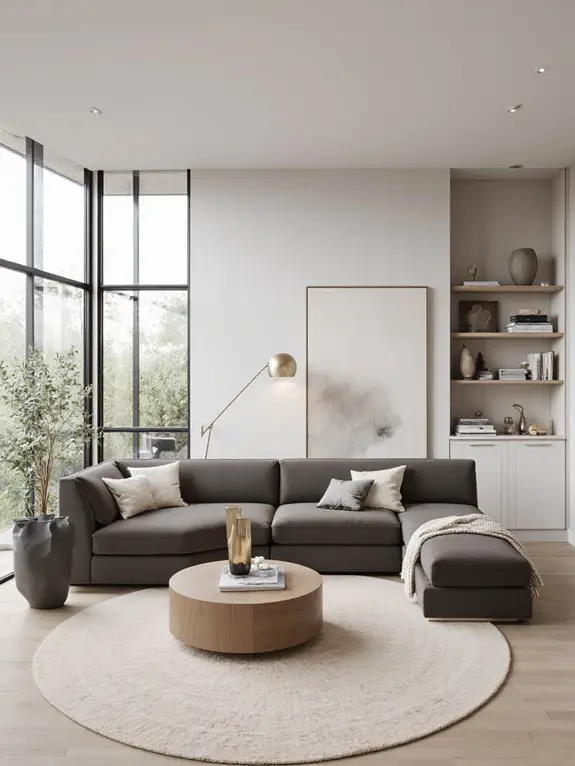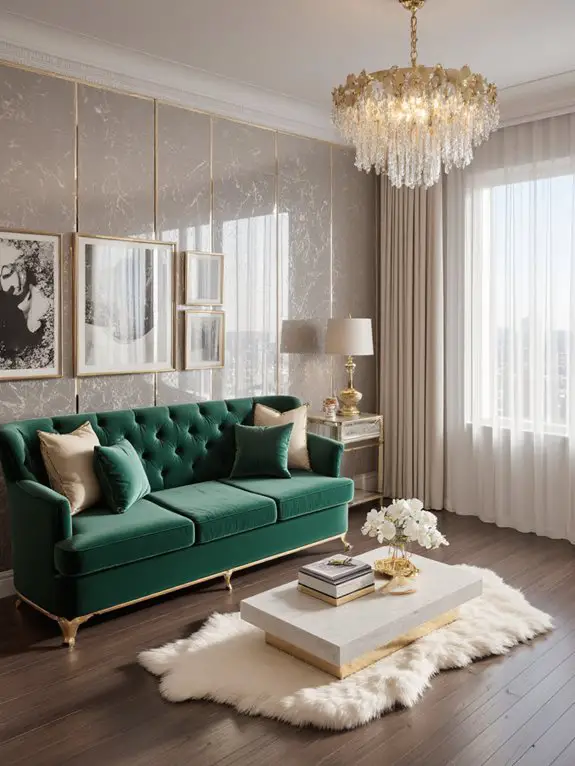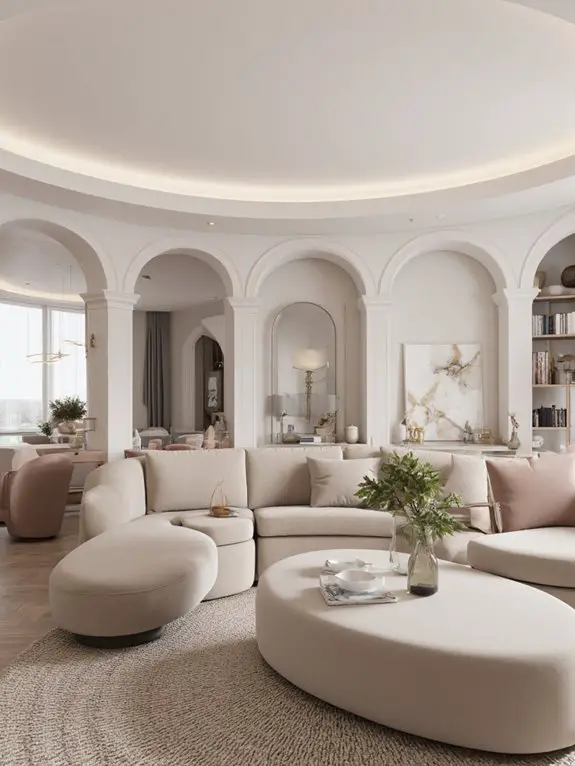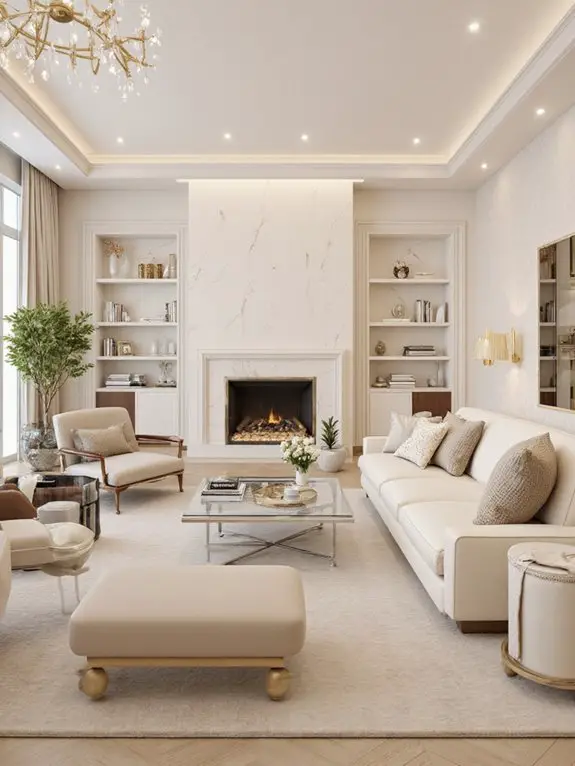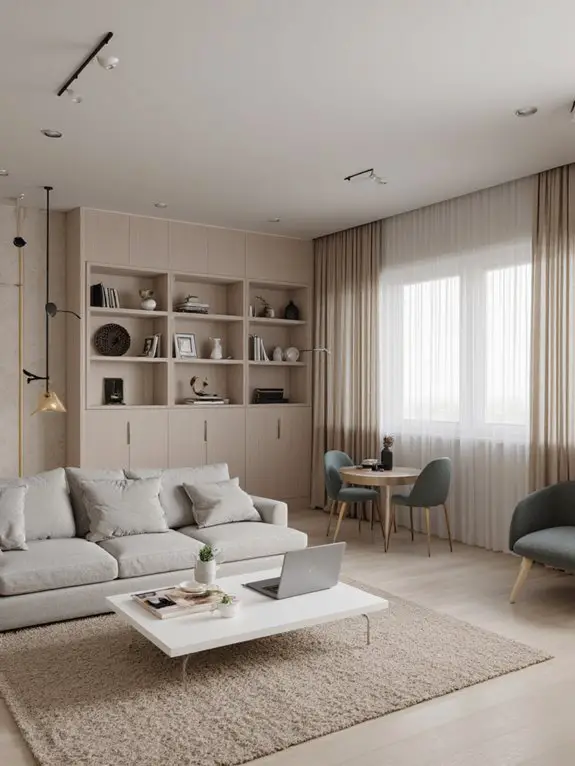I’ve noticed that living room trends this year blend functionality with bold aesthetics, offering fresh ways to create inviting and stylish spaces. Earthy color palettes like warm beige and olive green bring calm, while biophilic elements like potted plants and natural materials enhance connection to nature. Curved furniture softens layouts, and maximalist decor adds vibrancy with bold patterns and textures. Sustainable materials and smart home features guarantee eco-friendly convenience. Oversized artwork and mixed metals bring sophistication, making spaces both practical and visually striking. Explore further to uncover more inspiring ideas.
Earthy Color Palettes
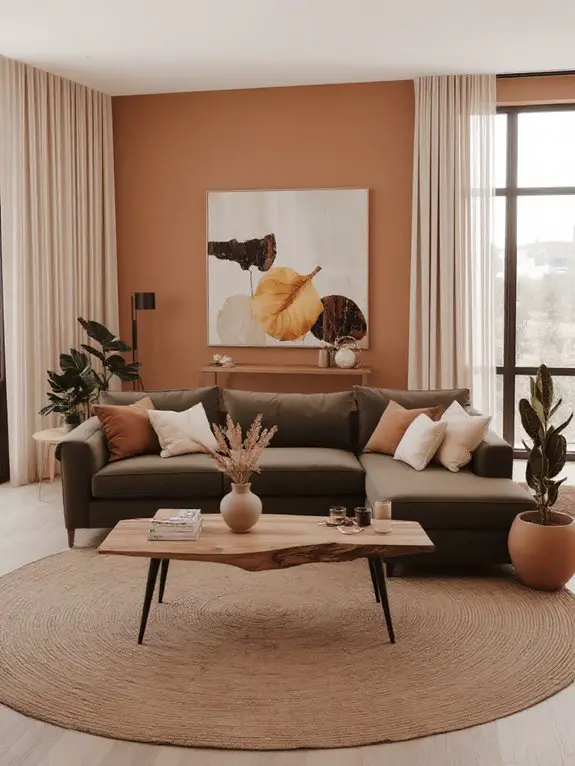
If you’re looking to create a calming and inviting living room, earthy color palettes are a timeless choice. I love using shades like warm beige, soft terracotta, and deep olive green because they bring a sense of nature indoors.
These colors work beautifully together and pair seamlessly with natural materials like wood and stone. I often start with neutral walls and layer in richer tones through furniture, rugs, or decor.
It’s easy to adjust the mood—lighter shades feel airy, while darker hues add depth and coziness. Earthy palettes are versatile, making them perfect for any style, from modern to rustic.
Biophilic Design Elements
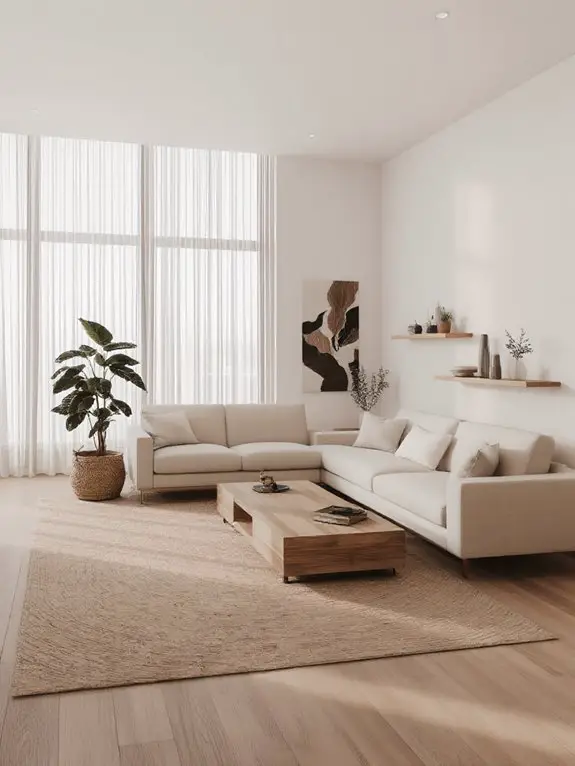
While earthy color palettes lay the foundation for a serene space, incorporating biophilic design elements takes the connection to nature even further. I love adding potted plants or hanging greenery to bring life and freshness into the room—think ferns, snake plants, or cascading ivy.
Natural materials like wood, stone, or jute rugs enhance the organic feel, while large windows or strategically placed mirrors maximize natural light. Water features, like a small tabletop fountain, introduce soothing sounds that mimic nature. These touches not only elevate the aesthetic but also promote well-being, making your living room a true sanctuary.
Curved Furniture Silhouettes
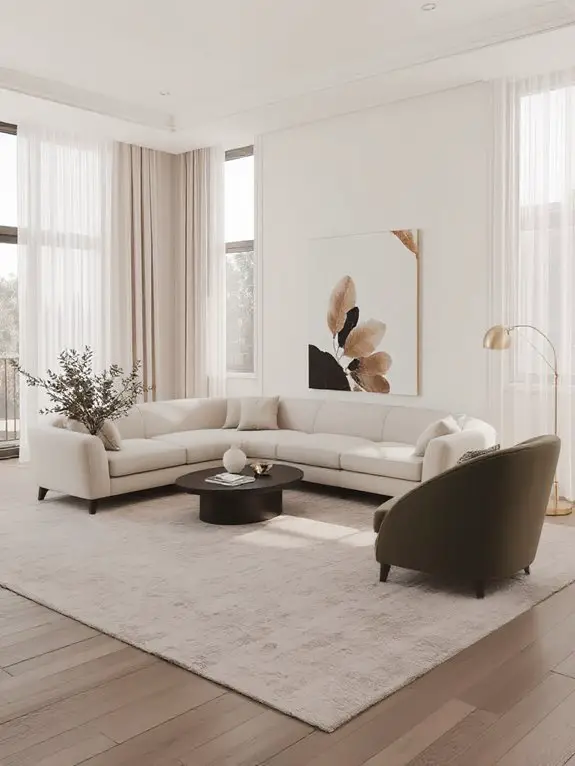
Curved furniture silhouettes are making a strong comeback, and I’ve found they’re perfect for softening the overall aesthetic of a living room. These rounded designs, from sofas to armchairs, create a welcoming and organic feel that contrasts beautifully with sharp lines and angular spaces.
I recommend incorporating pieces like curved sectional sofas or round coffee tables to introduce flow and balance. They’re also great for small rooms, as they visually open up the space.
When choosing materials, opt for plush fabrics like velvet or linen to enhance the cozy, inviting vibe. Curved furniture isn’t just stylish—it’s functional and timeless.
Maximalist Decor
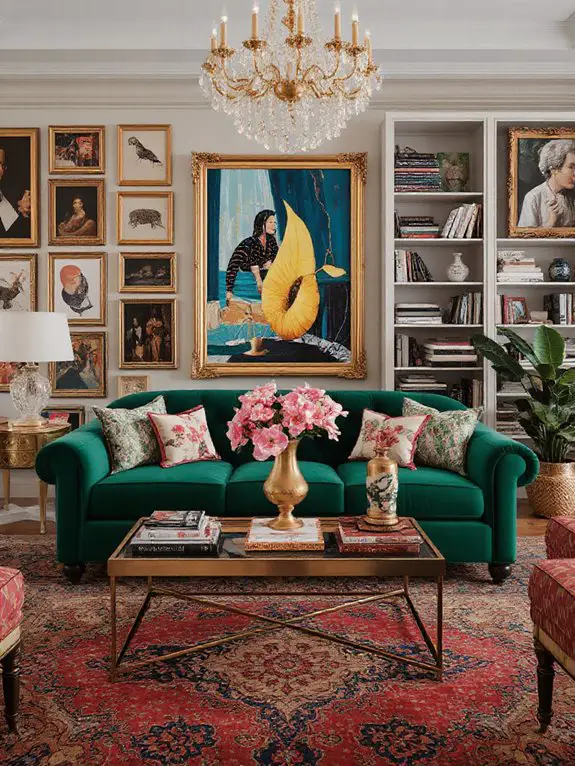
Maximalist decor thrives on boldness, inviting you to embrace a “more is more” philosophy that celebrates color, pattern, and texture. I find it’s about curating a space that feels layered and personal, where every piece tells a story.
Start with a vibrant palette, mixing hues that energize but still harmonize. Don’t shy away from bold patterns—think floral prints paired with geometric designs.
Layering textures like velvet, silk, and wool adds depth, while eclectic furniture and decor create visual interest. The key is balance; even maximalism needs cohesion.
Let your personality shine, and remember, it’s okay to break the rules. More really can be more.
Sustainable Materials
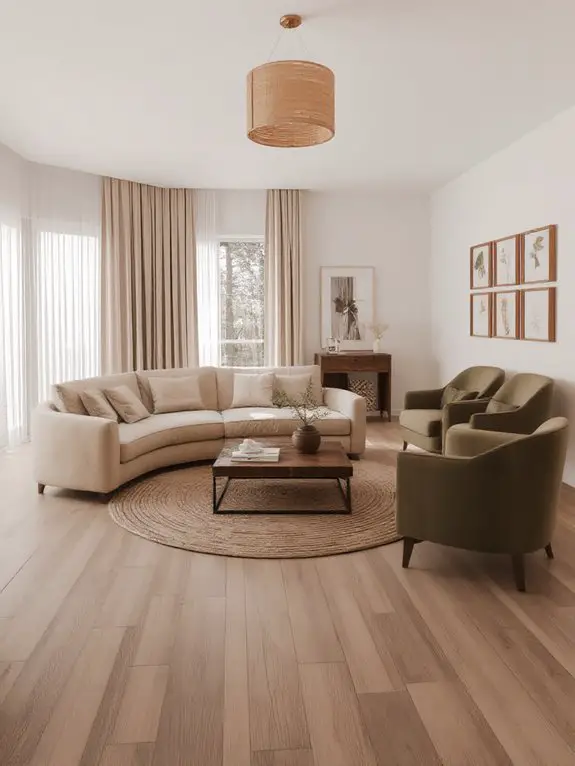
As sustainability becomes a priority in home design, I’ve found that incorporating eco-friendly materials into your living room doesn’t mean sacrificing style or comfort. Opt for furniture made from reclaimed wood or bamboo, which adds warmth and character while reducing waste.
I love pairing these with organic cotton or linen upholstery, as they’re durable and free from harmful chemicals. Rugs made from jute or recycled fibers can anchor the space beautifully.
For decor, consider upcycled items or ceramics from local artisans. These choices not only reduce environmental impact but also create a unique, intentional space that feels both modern and timeless.
Mixed Metal Finishes
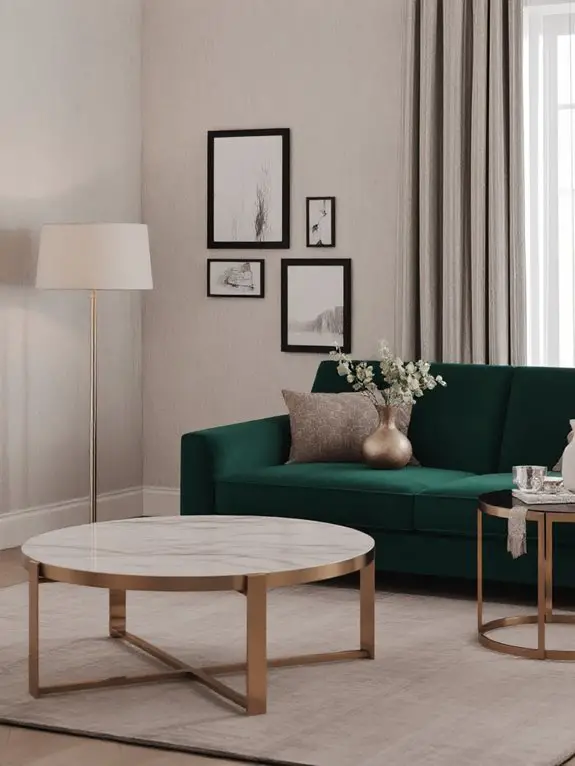
When designing a living room, I’ve found that embracing mixed metal finishes can elevate the space with depth and sophistication. Combining metals like brass, nickel, and iron adds visual interest without overwhelming the room.
I recommend starting with a dominant metal—like brushed gold for warmth—and accenting it with cooler tones, such as matte black or chrome, for contrast. Don’t shy away from layering textures; pair polished surfaces with brushed or hammered finishes.
The key is balance; let each metal complement the others while tying them together through cohesive elements like hardware, lighting, or decor. This approach achieves a polished, modern look.
Vintage Revival Pieces
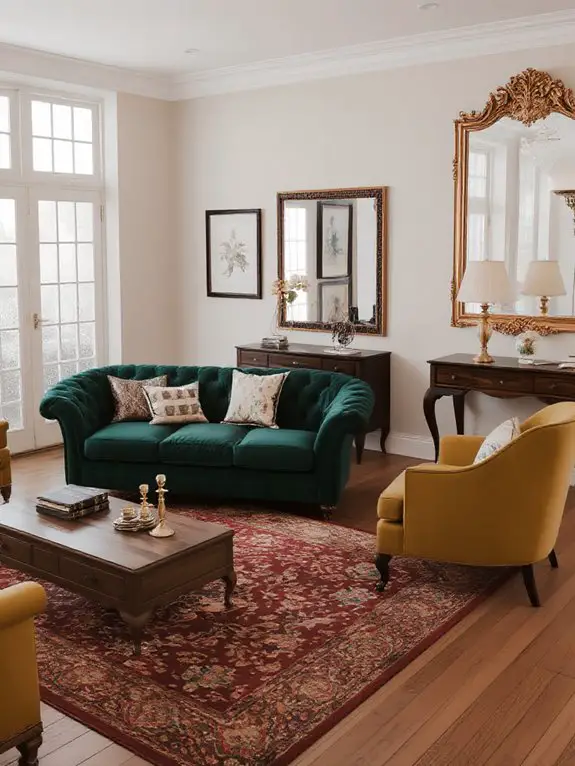
Incorporating vintage revival pieces into a living room can instantly infuse it with character and timeless charm. I love blending mid-century chairs, art deco side tables, or antique lamps with modern elements to create a curated, layered look.
When selecting pieces, I focus on quality craftsmanship and unique details—think carved wood, brass accents, or faded upholstery. Mixing eras keeps the space fresh rather than overly nostalgic.
I also recommend starting small, like adding a vintage mirror or a retro rug, to see how it complements your existing decor. These pieces tell a story, making the room feel lived-in and intentional.
Bold Wallpaper Statements
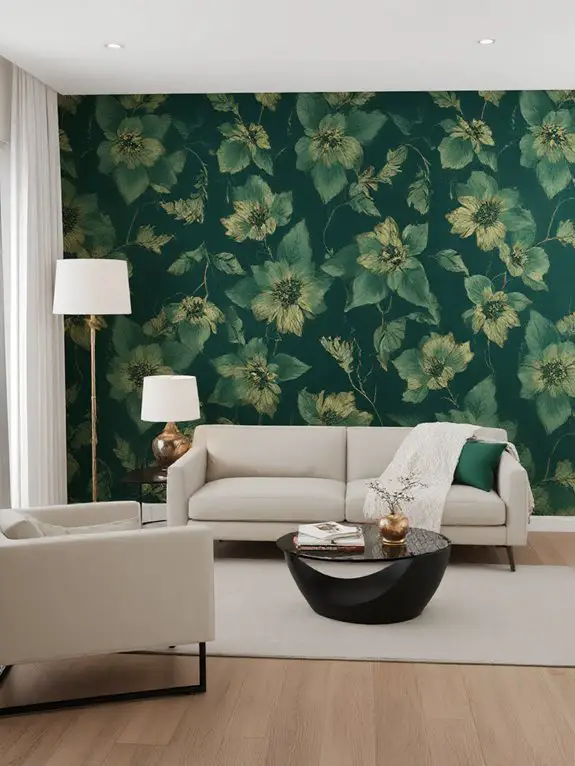
While wallpaper might seem like a bold choice, it’s a powerful way to transform a living room into a statement-making space. I’ve found that choosing a pattern with personality, like large-scale florals or geometric designs, can instantly elevate the room’s mood.
Don’t shy away from rich colors—deep blues, emerald greens, or even metallic accents can create depth and drama. Personally, I prefer using wallpaper on a single accent wall to avoid overwhelming the space.
It’s also worth investing in high-quality, peel-and-stick options for easy application and removal. Remember, the key is to let the wallpaper shine by keeping surrounding decor simple and cohesive.
Multifunctional Furniture
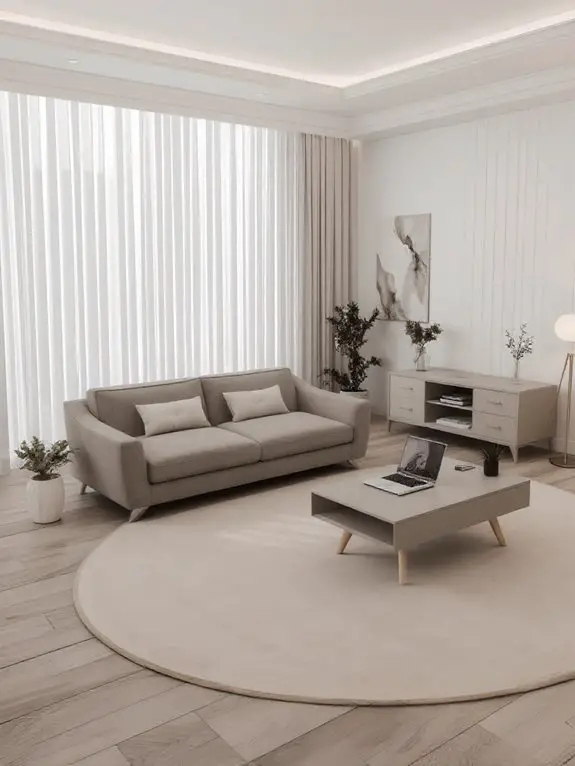
Multifunctional furniture offers a smart solution for maximizing space without compromising on style. I’ve found that pieces like sofa beds, ottomans with storage, and extendable tables are game-changers, especially in smaller living rooms.
These items not only serve their primary purpose but also adapt to your needs, whether it’s hosting guests or organizing clutter. I recommend choosing designs with clean lines and neutral tones to guarantee they blend seamlessly with your decor.
Investing in quality materials secures durability, so your furniture can handle frequent transformations. It’s a practical way to keep your living area functional and visually appealing, no matter the size.
Dark Moody Interiors
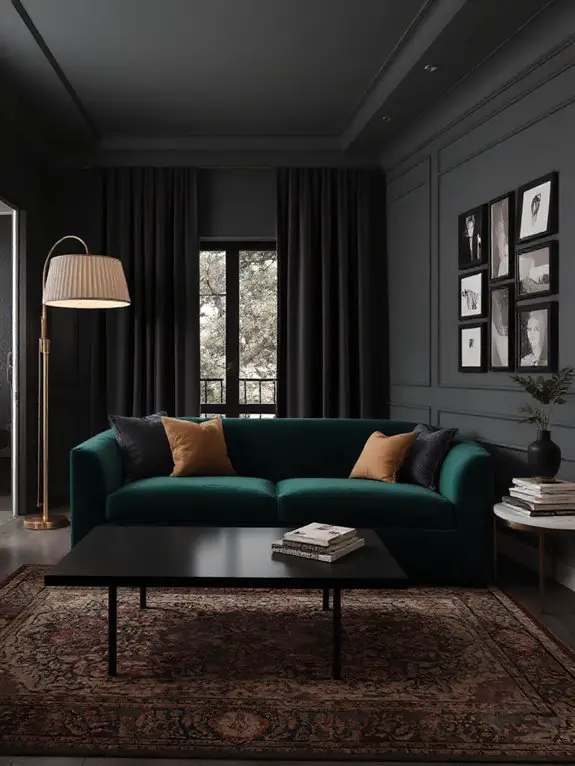
Dark moody interiors are perfect for creating a dramatic, intimate feel in your living room. I love using deep hues like charcoal, navy, or forest green on walls to instantly set the tone. Pairing these shades with rich, dark wood furniture or matte black accents amplifies the sophistication.
Lighting is key—I opt for warm, dimmable fixtures or candles to enhance the cozy ambiance. Adding metallic touches like brass or gold can provide subtle contrast without breaking the mood.
It’s a bold choice, but it makes the space feel personal and luxurious, perfect for unwinding or entertaining in style.
Textured Layering
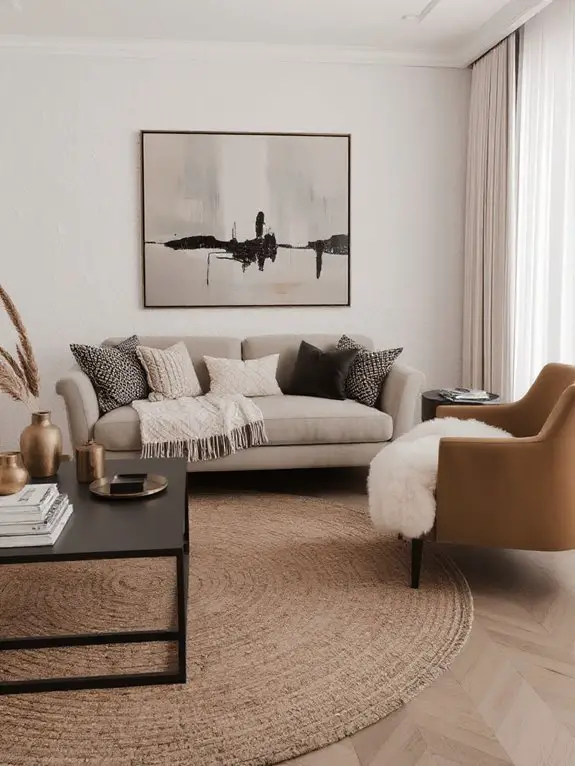
Textured layering transforms a living room into a sensory experience, adding depth and dimension to the space. I love mixing materials like chunky knits, smooth leather, and rough linen to create contrast.
Start with a neutral base, then layer in throws, pillows, and rugs with varying textures—think bouclé, velvet, or jute. Don’t shy away from combining patterns, but keep colors cohesive to avoid chaos.
A woven basket or a ceramic vase can add subtle tactile interest. The key is balance; too much feels cluttered, too little falls flat. It’s about crafting a room that invites touch while feeling effortlessly polished.
Japandi Style Fusion
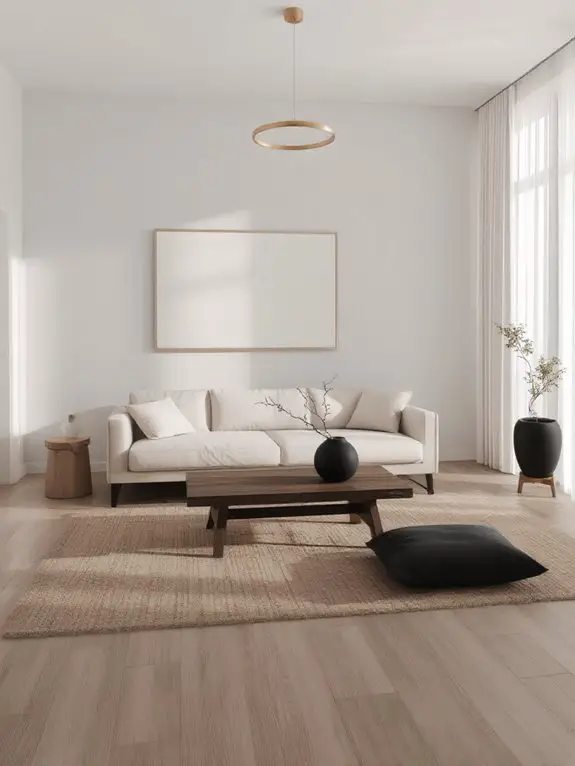
While blending two distinct design philosophies, Japandi style fusion marries the minimalist elegance of Japanese aesthetics with the cozy functionality of Scandinavian design. I find it’s all about balance—clean lines and neutral palettes meet warm textures and organic materials.
Think light woods like oak or ash paired with soft linens and muted tones like beige, gray, or muted greens. I aim to keep decor intentional, avoiding clutter while incorporating natural elements like potted plants or bamboo accents.
Functionality is key; furniture should be simple yet comfortable, like a low-profile sofa or a sleek wooden coffee table. This approach creates a serene, harmonious space.
Statement Lighting Fixtures
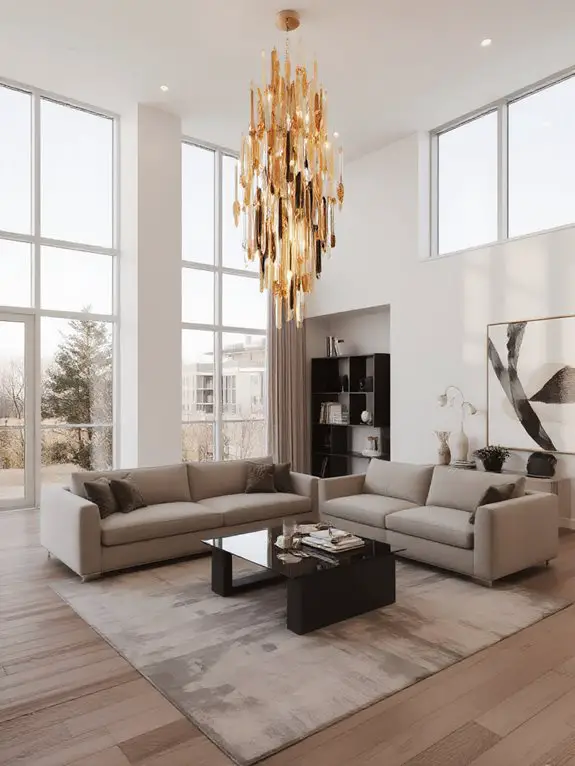
If you’re looking to elevate your living room, statement lighting fixtures can serve as both functional pieces and striking focal points. I recommend choosing designs that reflect your personal style, whether it’s a dramatic chandelier, a sleek pendant, or an oversized floor lamp.
Consider the scale of your space—larger rooms can handle bold, ornate fixtures, while smaller areas benefit from minimalist designs. Don’t overlook the impact of materials like metal, glass, or woven textures, which add depth and character.
Pay attention to light temperature too; warm tones create coziness, while cooler hues enhance modern aesthetics. Thoughtful placement guarantees the fixture enhances the room’s ambiance and flow.
Warm Wood Tones
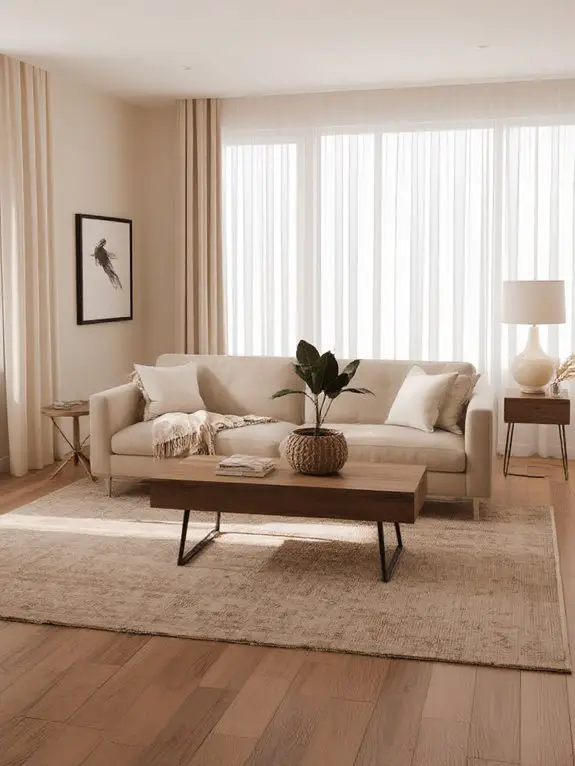
As I consider ways to bring warmth and timeless appeal into my living room, incorporating warm wood tones stands out as a versatile and inviting choice. I love how oak, walnut, or cherry finishes create a cozy atmosphere while remaining neutral enough to pair with various styles.
I’d focus on key pieces like a wooden coffee table, shelving, or even a statement sideboard to anchor the space. Mixing lighter and darker tones can add depth, and I’d balance them with soft textiles or greenery to avoid a heavy feel.
Warm wood tones not only elevate aesthetics but also guarantee the room feels grounded and welcoming.
Art Deco Influences
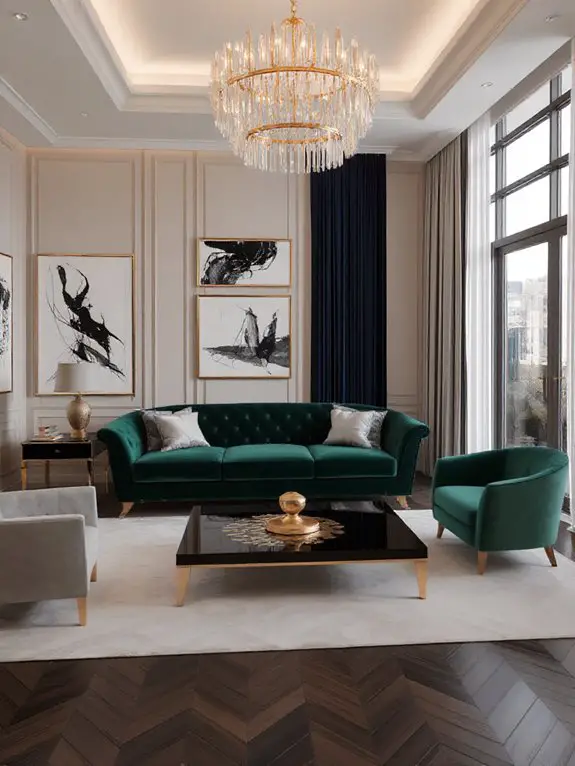
Art Deco influences can transform a living room into a space that exudes sophistication and glamour, blending bold geometry with luxurious materials. I love incorporating mirrored surfaces, velvet upholstery, and metallic accents like gold or chrome to evoke that quintessential 1920s elegance. Geometric patterns in rugs, throw pillows, or wall art add visual interest, while streamlined furniture with clean lines keeps the look cohesive.
I often choose rich jewel tones—emerald, sapphire, or ruby—paired with black or white to create a striking contrast. Layering in statement lighting, like a tiered chandelier or angular table lamps, ties everything together for a timeless yet modern vibe.
Open-Concept Layouts
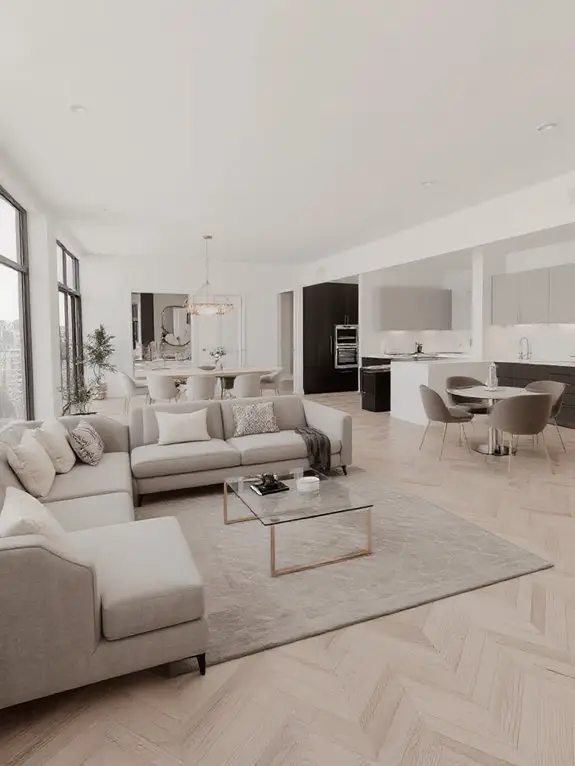
When designing a living space, I always consider how an open-concept layout can enhance both functionality and aesthetic appeal. Removing walls creates a seamless flow between rooms, making the area feel larger and more inviting. I love how it encourages social interaction, allowing family and guests to connect effortlessly, whether you’re cooking, dining, or relaxing.
It’s also easier to maximize natural light, which brightens the entire space. To define zones without disrupting openness, I use rugs, furniture placement, or subtle lighting changes. An open-concept layout adapts to modern lifestyles, offering versatility and a sense of cohesion that’s both practical and stylish.
Neutral Monochromatic Schemes
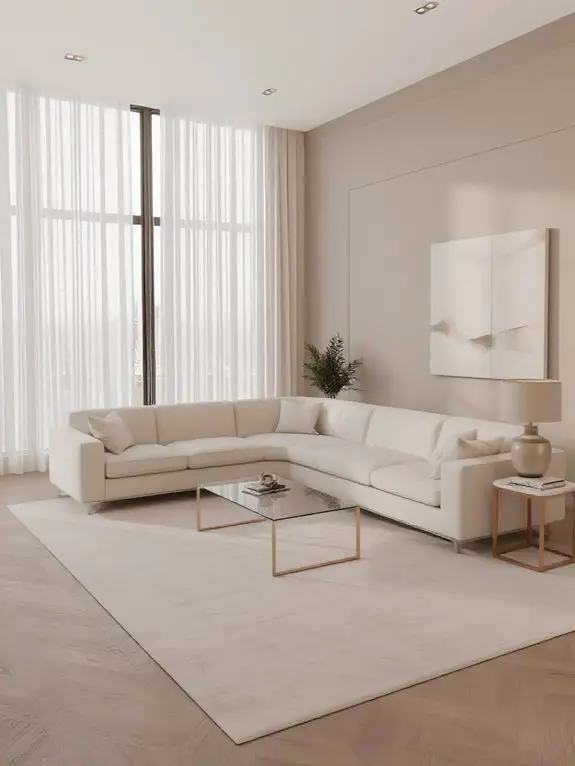
Neutral monochromatic schemes create a timeless, sophisticated foundation for any living room. I’ve found that sticking to shades of beige, gray, or ivory makes the space feel cohesive and calming. To avoid monotony, I layer textures like linen, wool, and velvet to add depth.
Lighting plays a key role—soft, warm tones enhance the serene vibe, while metallic finishes in silver or gold introduce subtle contrast. I also recommend incorporating natural elements like wood or stone to ground the design.
This approach keeps the room versatile, allowing me to switch out accents easily without disrupting the overall harmony. It’s both practical and elegant.
Handmade Ceramic Accents
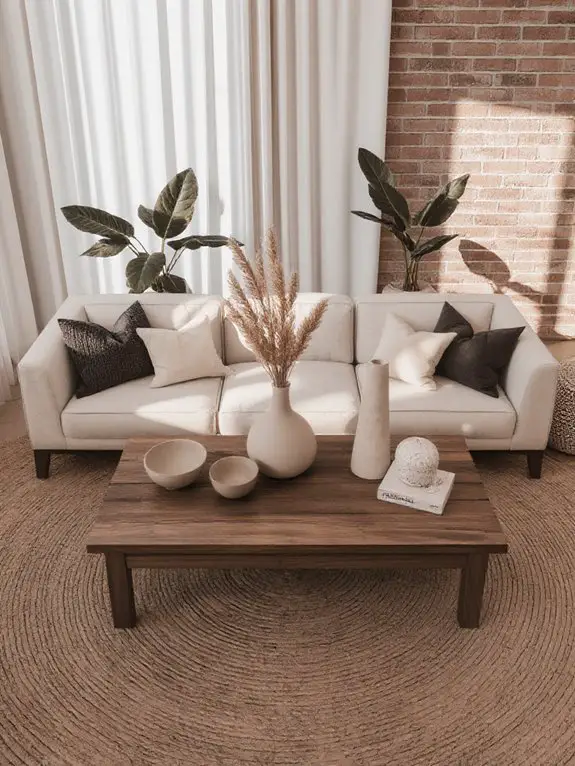
Handmade ceramic accents bring a unique, artisanal charm to a living room, instantly elevating its character. I love how each piece tells a story, with subtle imperfections that add authenticity.
I often recommend incorporating vases, bowls, or sculptures in rich, earthy tones to complement modern or minimalist spaces. They’re versatile, pairing beautifully with wood, metal, or linen textures.
I suggest placing them on shelves, coffee tables, or mantels for a curated look. When choosing ceramics, I lean toward functional yet decorative items, like catchall dishes or planters, to blend style with practicality.
Handmade pieces create warmth and individuality, making any room feel more inviting.
Global-Inspired Decor
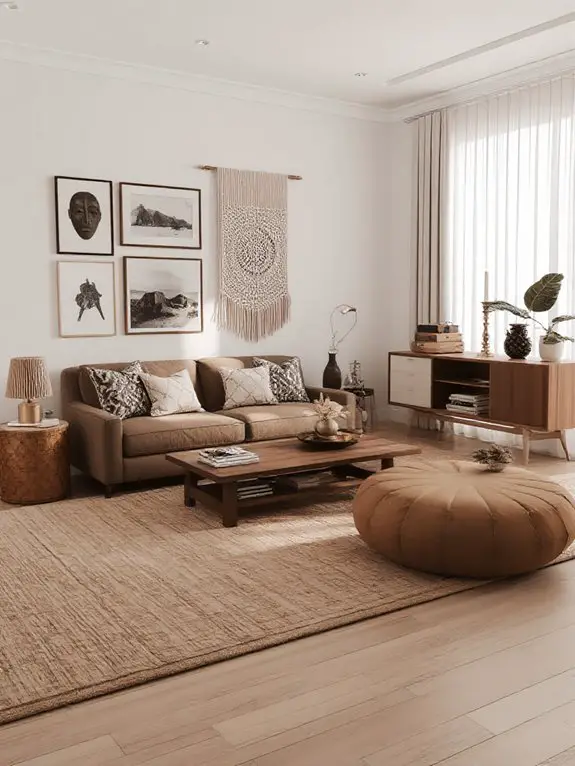
Global-inspired decor infuses a living room with a sense of adventure and cultural richness, transforming it into a vibrant, worldly retreat. I love incorporating pieces like Moroccan rugs, hand-carved wooden furniture, or Japanese shoji screens to create a layered, eclectic look. Mixing textures and patterns from different cultures adds depth and personality.
I often start with a neutral base and layer in global accents—think ikat pillows, tribal baskets, or vintage maps. Including authentic artifacts, like a Balinese sculpture or Indian brass lantern, makes the space feel curated rather than random. Balance is key; too many elements can overwhelm, so I focus on a few standout pieces that tell a story.
High-Contrast Color Blocking
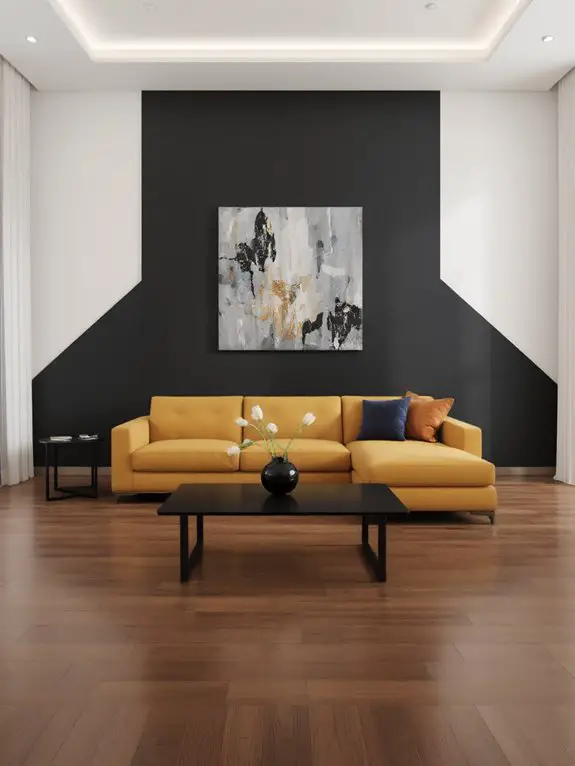
High-contrast color blocking creates a bold, dynamic statement in any living room, instantly drawing the eye and energizing the space. I love pairing deep navy with crisp white or vibrant yellow with charcoal gray to achieve this effect.
It’s all about balance—pick one dominant color and let the secondary shade accentuate it. I typically use furniture, accent walls, or even large artwork to introduce these bold contrasts.
To avoid overwhelming the room, I stick to clean lines and minimal patterns. High-contrast color blocking feels modern yet timeless, and it’s an easy way to make your living room feel intentional and polished.
Cozy Reading Nooks
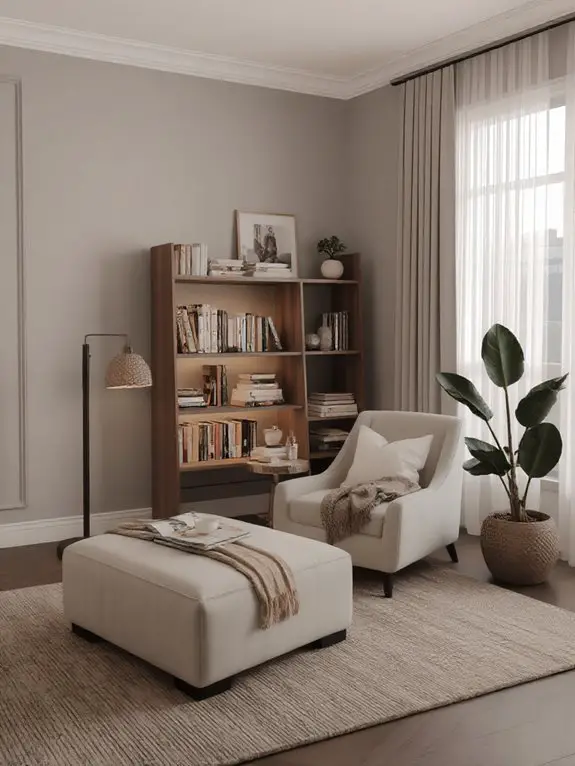
While bold contrasts can energize a living room, there’s also something to be said for creating a quiet, inviting corner for relaxation. I’ve found that a cozy reading nook can transform an underutilized space into a personal retreat.
Start with a comfortable chair or chaise lounge, layered with soft throws and cushions. Add a small side table for books or tea, and prioritize warm, ambient lighting with a floor or table lamp.
Positioning the nook near a window for natural light enhances the experience. Finally, incorporate a bookshelf or basket nearby to keep essentials within reach for uninterrupted reading.
Smart Home Integration
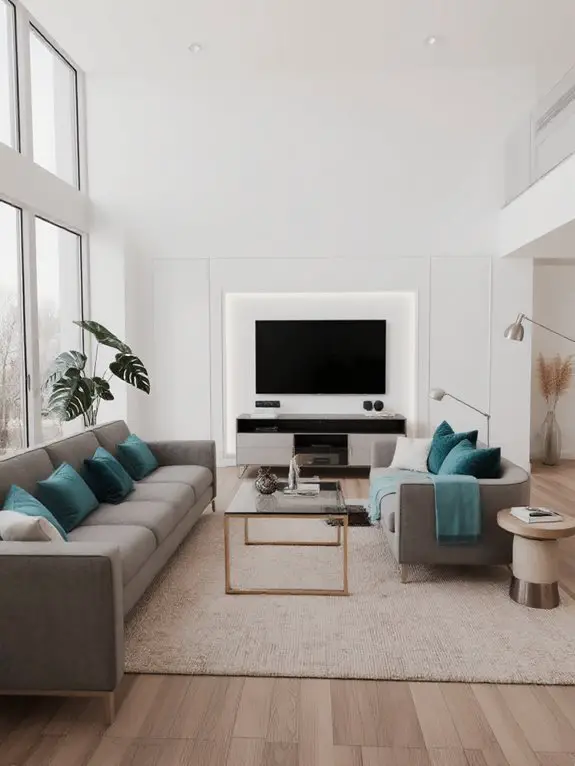
As technology continues to evolve, I’ve noticed that integrating smart home features into the living room can substantially enhance both convenience and functionality. Voice-controlled assistants like Alexa or Google Home let you adjust lighting, temperature, or entertainment systems hands-free.
Smart plugs and bulbs sync with apps, allowing scheduled routines or remote control. I recommend starting with a central hub to streamline devices, ensuring compatibility.
Motorized shades or smart TVs add seamless control, while security cameras offer peace of mind. Prioritize user-friendly setups—overcomplicating can deter daily use.
Smart integration transforms your living room into a responsive, efficient space without overwhelming the design.
Oversized Artwork
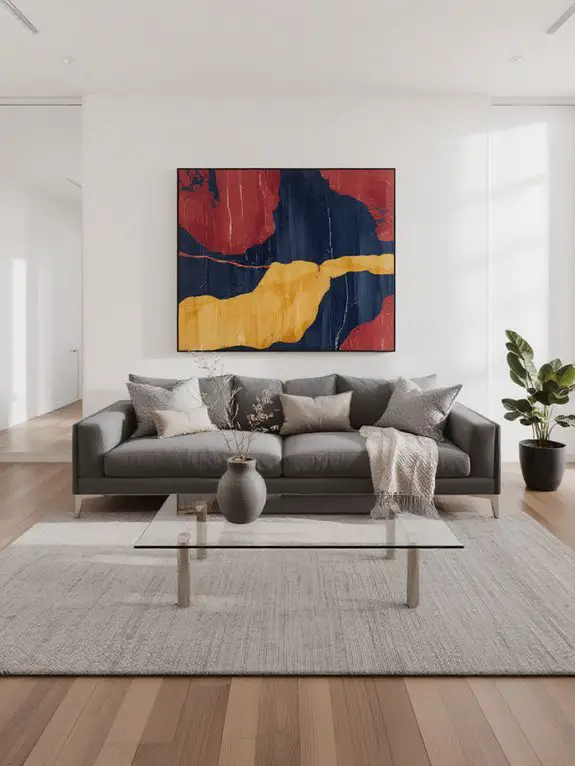
If you’re looking to make a bold statement in your living room, oversized artwork can instantly elevate the space by becoming a mesmerizing focal point. I’ve found that choosing a piece that complements your color palette while adding contrast creates harmony without overwhelming the room.
A single, large canvas or framed print above the sofa or fireplace draws the eye and anchors the decor. Opt for abstract designs, landscapes, or even photography—just make certain it resonates with your personal style.
Keep the surrounding walls minimal to let the artwork shine. It’s a simple yet impactful way to infuse personality and sophistication.
Leather and Velvet Combos
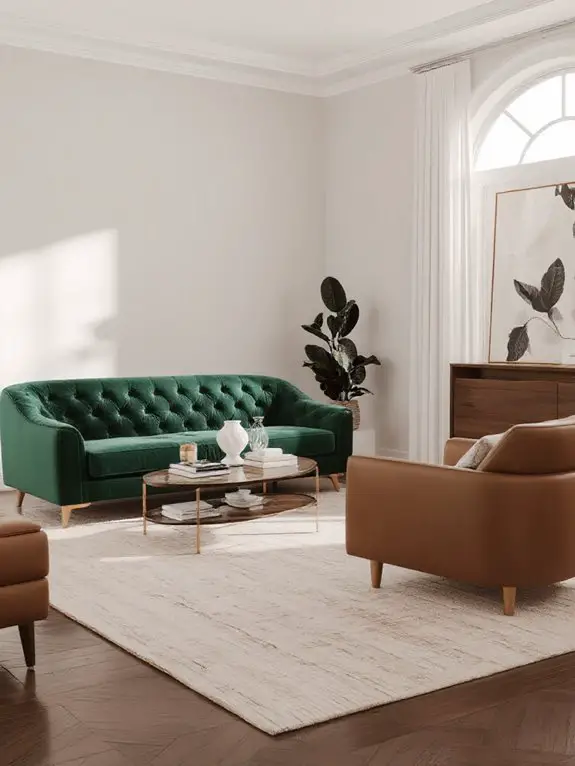
Adding texture and contrast to your living room can transform its feel, and leather and velvet combos are an excellent way to achieve this. I love how the sleek, polished look of leather pairs beautifully with the soft, luxurious texture of velvet—it’s a match made in design heaven.
For example, try a leather sofa with velvet cushions or a velvet armchair next to a leather ottoman. The key is balancing the two materials so one doesn’t overpower the other.
I often suggest neutral tones for versatility, but bold colors can make a statement. This combo adds depth and sophistication to any space effortlessly.
Indoor-Outdoor Flow Spaces
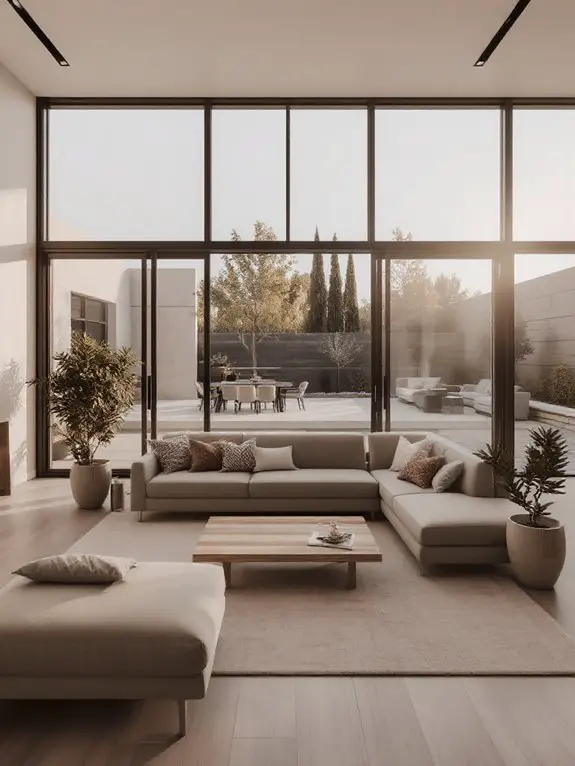
Crafting a smooth indoor-outdoor connection in your living space can enhance both its practicality and visual charm. I’ve discovered that expansive sliding glass doors or bi-fold doors are transformative, softening the divide between interior and exterior.
Employing matching flooring materials, such as stone or wood, for both zones boosts harmony. Including weather-proof furniture and textiles safeguards durability while preserving style.
I also enjoy integrating greenery, like potted plants or a vertical garden, to ease the shift. Appropriate lighting, such as string lights or lanterns, fosters a warm atmosphere.
This design strategy welcomes nature indoors, expanding your living room’s feel and its bond with the outdoors.
Frequently Asked Questions
How to Choose the Right Rug Size?
I measure my seating area first, then pick a rug that fits under the front legs of my furniture or the entire set. I consider leaving equal floor space on all sides to balance the room.
What Lighting Is Best for Small Spaces?
I’d go for layered lighting—overhead fixtures, wall sconces, and floor lamps—to maximize space. Opt for slim, vertical designs or adjustable arms to keep things open. Mirrors help bounce light around, making the room feel bigger.
How to Arrange Furniture in a Long Living Room?
Funky furnishings fit fantastically in lengthy layouts. I’d place pieces parallel to the walls, creating cozy clusters. I’ll use a rug to define zones, float sofas for flow, and balance with bookshelves or plants at intervals.
What Are the Best Plants for Low-Light Rooms?
I’d choose plants like snake plants, pothos, or ZZ plants for low-light rooms since they thrive without much sun. They’re low-maintenance, purify the air, and add life to spaces with minimal natural light.
How to Mix Patterns Without Clashing?
Mixing patterns is like conducting an orchestra—balance is key. I stick to one dominant pattern and pair it with smaller, complementary ones. I keep colors consistent and vary scales to avoid chaos, ensuring harmony in every detail.

